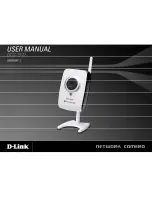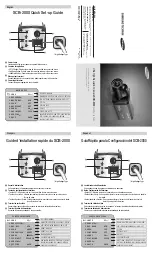
The anti
Figure 2 shows a possible position of the detectors in order to protect
a long and narrow access (e.g. a glass window).
WARNING: do not use this position if the sensors are exposed to
direct sunlight.
ANTI-RIP TAMPER
The anti-rip tamper is realized through a magnetic contact made up
by the reed that is on the back of the card of the detector and by a
magnet that shall be built in beneath the detector. Figure 3 shows
how magnet and detector shall be installed.
The provided template enables to properly position the magnet with
respect to the detector.
Check that the magnet does not move from its position if the sensor
is ripped.
Tip: before drilling and installing the anti-rip tamper, complete the
installation and check that the position chosen for the detector
actually covers the area to be protected. If this is the case and it is
not necessary to find another position, remove the detector, install
the magnet and mount the detector again.
Figure 3
To fix the detector:
1)
Remove the cover of the device by loosening the screws on the
cover and lift it (figure 4).
2)
Fix the base of the detector on the frame or where it is
required, with two screws or screw anchors, as appropriate.
Figure 4
If you want to use also the external contact, it is necessary to drill the
external part of detector frame. Figure 5 shows in grey the frame
areas where it is necessary to make the hole to let the cable pass.
Figure 5
WARNNG! Drilling the detector frame reduce the IP level of the
device. The diameter of the hole should be as small as possible
according to the size of the cable that shall pass.
Be careful that water does not enter from the hole as it could damage
the electronic circuits of the device.
Both external contact and tamper wires can be connected to the
connection terminals (figure 6).
IMPORTANT: if the inputs were not disabled through the
programming executed on the control unit, the non-used input
(Tamper or Contact) has to be short-circuited through a jumper on
the terminal.
Figure 6
2.2
Programming
To program the device:
1. Put the control unit into sensor programming mode.
2. Power the detector by removing the insulating strip of the battery.
3. Trigger a transmission from the detector by passing a hand in
front of the sensors.
4. Program the detector from the control unit.
There are some parameters common to all detector types that are
shown in the installation manual of the control unit and a group of
parameters that are specific to the dual perimeter detector.
The detector specific parameters are:
Parameter Value Function
1
SI
(YES)
Active anti-masking
NO
Inactive anti-masking
2
OR
IR sensors operation in OR mode
AND IR sensors operation in AND mode
3
2
IR sensitivity: 2 pulse count
1
IR sensitivity: 1 pulse count
4
NO
Disabled external contact
SI
(YES)
Enabled external contact
5
SI
(YES)
Active IR signal LED
NO
Inactive IR signal LED
6
SI
(YES)
Active anti-rip tamper
NO
Inactive anti-rip tamper
Underlined values are factory settings.
The anti-masking function detects fixed obstacles at a distance of at
least 25 cm from the IR sensors. Within 5 seconds from the
detection, a tampering alarm is sent.
If both a jamming and a tampering (tamper) attempts are detected,
the first event occurred is signaled.
IR sensors can be operated in OR or AND mode.
In case of OR mode, it is enough that the sensor detects a movement
to activate the alarm signal. In this way a higher sensitivity is
provided.
In case of AND mode, both sensors shall detect the movement in
order to activate the alarm signal. The immunity to false alarms will
increase.
The pulse count adjusts the readiness to send the alarm.
Signal LED (figure 5) is used to check the IR coverage. It turns on
each time the IR sensors execute a detection.
The LED can be visible also when the detector is closed.
WARNING: once you have executed the check and calibration,
deactivate the LED signal in order to not reduce the battery
autonomy.
In case of enabled external contact, the detector transmits both the
closing and the opening of the wired contact connected to the
terminals.
In case of deactivated anti-rip tamper, the reed is inhibited and the
device behaves as if the contact were always closed.
In case of active anti-rip tamper, the detector signals any possible
removal.
The function Invia supervisione (Send Supervision) is active because
it is a factory setting.
2.3
Completion and test
Lay the cover back on the device and fix it with the screws.
WARNING: the coverage has to be laid on the right side. The
coverage openings for IR sensors shall be above the battery
compartment.
Proceed with the detector test, by following the testing instructions
encompassed in the installation manual of the control unit.
The LED turns on each time the sensors detect a movement within
the covered area. This enables to check possible shaded areas and
to move the detector, if required.
At the end of the test, disable the LED signals through the
programming.
3 Maintenance
3.1
Cleaning
To clean the device use a dry cloth.
Regularly check that the IR sensor slot is clean and without any
obstacle.
3.2
Battery replacement
The battery in the detector shall not be disposed as urban waste
(Directive, 2006/66/EC), as it is subject to separate waste collection in
order to avoid environmental damages.
Battery shall be replaced by qualified personnel.
To replace the battery:
1. Put the control unit into maintenance status (please refer to the
installation manual of the control unit).
2. Remove the detector cover.
3. Remove the exhausted battery.
4. Insert the new battery.
5. Lay the cover back on the detector.
6. Execute the test of the detector to be sure it works.
7. Exit the maintenance status, if required.
3.3
Reset
In order to execute the reset of the detector, remove and insert the
battery again.
A sensor already acquired on the control unit can be acquired again
on the same control unit without executing the reset.
- 4 -
- 5 -
- 6 -
- 7 -
- 8 -
- 9-




















